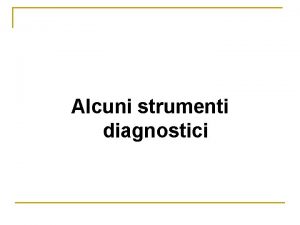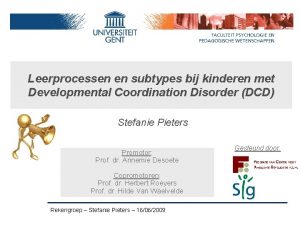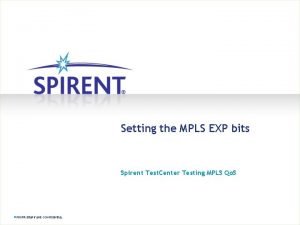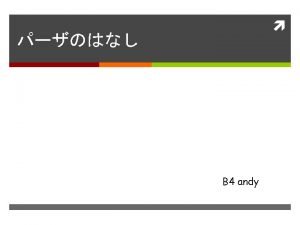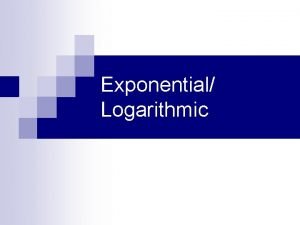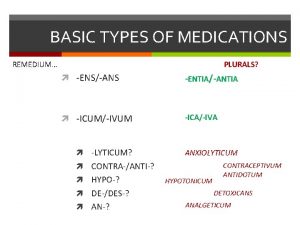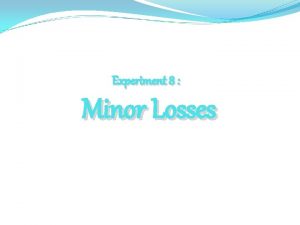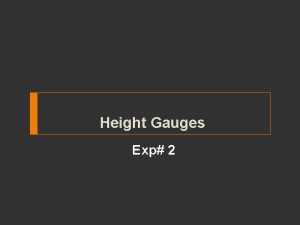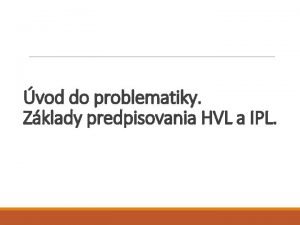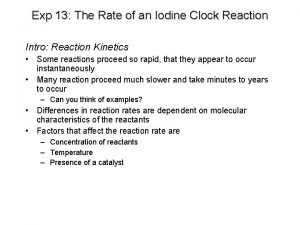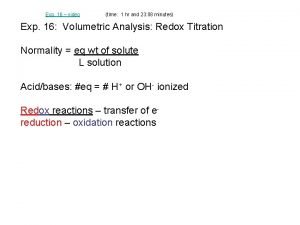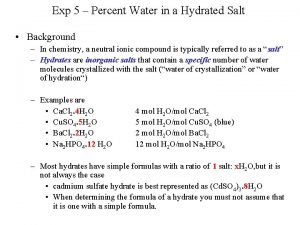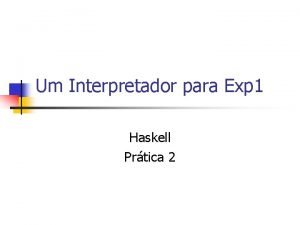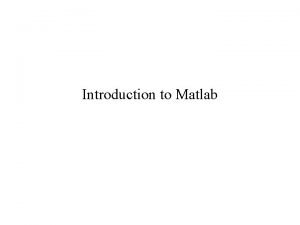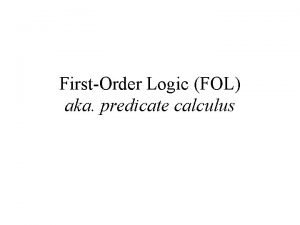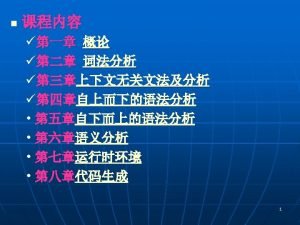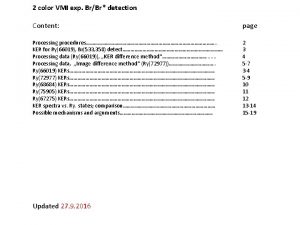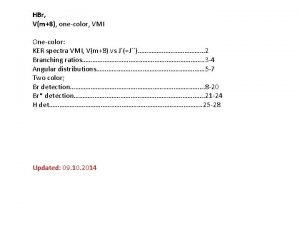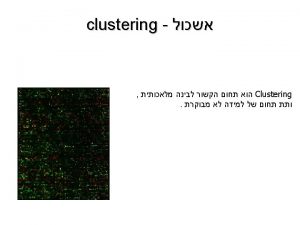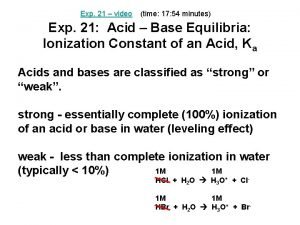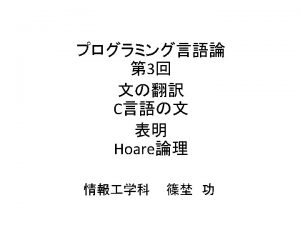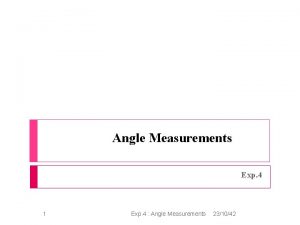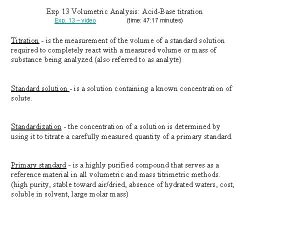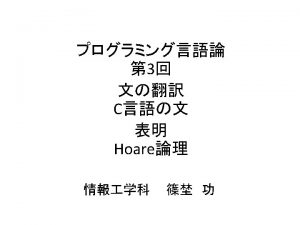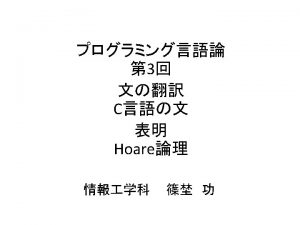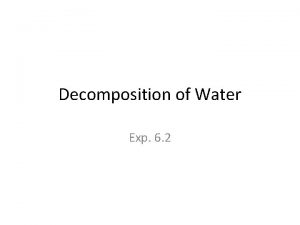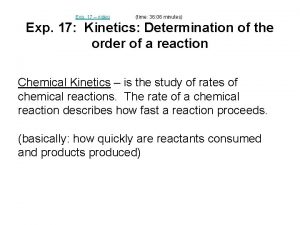2 color VMI exp CH 3X v 1







![5 s : [3/2]5 s 5 s’ : [1/2]5 s 5 s 5 s’ 5 s : [3/2]5 s 5 s’ : [1/2]5 s 5 s 5 s’](https://slidetodoc.com/presentation_image/a618699a367e9b7775e797f3a538bae6/image-8.jpg)






















- Slides: 30

2 color VMI exp. CH 3(X; v 1 v 2 v 3 v 4) detection; https: //notendur. hi. is/~agust/rannsoknir/Crete 16/PPT-161116 -CH 3 Br(5). pptx Content: KERs for Ry(72977; 274. 14 nm), CH 3(211) detection…………………. . possible procedures…………………………………. . CH 3 Br absorption spectra and possible probe absorption……………. . Image and KER for Ry(72977; 274. 14 nm), CH 3(000) detection…. ………………. . Comparison with Theos work from 2009…………………. Vibrational frequencies: CH 3´s and CH 3 Br´s…………………………. CH 3 2 color KERS and possible explanation………………. . …………………. vibrational structure…………………………. comparison of peaks due to 1 hv excitation and CH 3(X) + Br/Br* formation……. . Udated: 180816 (slide 30) pages: 2, 4 -6 3 7 -9 12 -16 19 -28 29 30 10 -11 17 -18

KERs (xx) / CH 3(211; 329. 5 nm) detect. : i. e. : CH 3**(3 p, 2 A 2; 0100) CH 3 (X ; 0100) 2 -color; Both lasers Ry(2 hv/cm-1): 72977/274. 14 nm (10. 11. 16) Pump (Dye laser; 274. 14 nm; 72977(Ry)) Probe (MOPO; 329. 5 nm; CH 3(211) Could these be due to CH 3+ formed via CH 3 Br + 1 hv and/or 2 hv(274. 14) -> CH 3 + Br*/Br ? e. V https: //notendur. hi. is/~agust/rannsoknir/Crete 16/PXP-161116. pxp; Gr: 1, Lay: 0 https: //notendur. hi. is/~agust/rannsoknir/Crete 16/XLS-160912. xlsx; Waves.

To top i. e. : according to the 2 color processes: CH 3 r o col n: o Tw ctio e det c) CH 3+ + Br/Br* CH 3+ + Br/(Br*) c) 3 hv b) Ry(p) CH 3* + Br/(Br*) CH 3 **(3 p 2 A 2)+ Br/Br* pump KERs 2 hv Ry(s)? 2 hv a) 1 hv KERs 1 hv a-b) probe CH 3 + Br* CH 3 + Br See also https: //notendur. hi. is/~agust/rannsoknir/Crete 16/PPT-160921 -CH 3 Br(3). pptx slide 41

2 -color; Both lasers Ry(72977; 274. 14 nm); CH 3(211; 329. 5 nm) detect. : ? Do not understand From Pavle, 10. 11. 2016

Pump (Dye laser; 274. 14 nm; 72977(Ry)) From Pavle, 10. 11. 2016

Probe (MOPO; 329. 5 nm; CH 3(211) From Pavle, 10. 11. 2016

Absorption spectra for CH 3 Br 103 – 207 nm (~48400 – 96800 cm-1) cm-1 https: //notendur. hi. is/~agust/rannsoknir/Crete 16/Absorbance_spectra_CH 3 Br_vs_CH 3_res. pxp ; Gr: 2
![5 s 325 s 5 s 125 s 5 s 5 s 5 s : [3/2]5 s 5 s’ : [1/2]5 s 5 s 5 s’](https://slidetodoc.com/presentation_image/a618699a367e9b7775e797f3a538bae6/image-8.jpg)
5 s : [3/2]5 s 5 s’ : [1/2]5 s 5 s 5 s’ cm-1 2 hv energy for probe laser for (329. 5 nm)CH 3(X) - - - 1 hv absorption spectra Locht et. al. 2005 (see link) -------http: //satellite. mpic. de/spectral_atlas/cross_sections/Halogeno-alkanes+radicals/Bromoalkanes/CH 3 Br_Locht(2005)_298 K_103 -207 nm. txt https: //notendur. hi. is/~agust/rannsoknir/Crete 16/Absorbance_spectra_CH 3 Br_vs_CH 3_res. pxp ; Gr: 2

5 s’ 0 Close up of region where 2 hv probe laser reaches. Definitely some absorbance in this region for CH 3 Br n 2 n 3 cm-1 https: //notendur. hi. is/~agust/rannsoknir/Crete 16/Absorbance_spectra_CH 3 Br_vs_CH 3_res. pxp ; Gr: 2 Causley and Russel (1974)

Pavlé; e-mail 15. 11. 2016: : Initially we wanted to record ground state CH 3 through 000 vibronic transition at around 333. 5 nm, but the power of the laser at 333. 5 was a bit low. We recorded only one image and decided to leave this for later. You can see the image in the first attachment, it shows some rings. : Ry(72977; 274. 14 nm) 2 -color exp. CH 3 (000) detection NB: Worth getting a KER!

2 -color; Both lasers; Ry(72977; 274. 14 nm); CH 3(000; 333. 5 nm) detect. : i. e. : CH 3**(3 p, 2 A 2; 0000) CH 3 (X ; 0000) From Pavle, e-mail, 17. 11. 2016

https: //notendur. hi. is/~agust/rannsoknir/papers/jcp 130 -034304 -09. pdf; V. Blanchet et al. 2009 https: //notendur. hi. is/~agust/rannsoknir/papers/pccp 11 -2234 -09. pdf; Theo et al. , 2009 left arrow: 1 hv = 29976 cm-1; right arrow: 29069. 8 cm-1 # + + 2 # CH 3 + Br CH 3 Br **(B E) CH 3 Br+**(A 2 A 1) # Our Scanning range Ours # https: //notendur. hi. is/~agust/rannsoknir/Crete 16/XLS-160912. xlsx; “Energetics” https: //notendur. hi. is/~agust/rannsoknir/Crete 16/PXP-161130 -energetics-CH 3. pxp; Gr: 0; Lay: 0

2 hv for probe = 329. 5 nm (CH 3, 211 detection) Region scanned by Theo, 2009 *: * https: //notendur. hi. is/~agust/rannsoknir/papers/pccp 11 -2234 -09. pdf https: //notendur. hi. is/~agust/rannsoknir/Crete 16/XLS-160912. xlsx; “various things” https: //notendur. hi. is/~agust/rannsoknir/Crete 16/Absorbance_spectra_CH 3 Br_vs_CH 3_res. pxp ; Gr: 2, Lay: 0 Standard Absorption spectrum cm-1

CH 3; KERs /, pump = 274. 14; probe = 329. 5 nm (CH 3, 211 detection) and comparison with Theos work from 2016: Max thresholds for our data as indicated pump probe 2 colors probe # CH 3 Br+(E 1/2) + 1 hv CH 3++Br/Br* CH 3 Br+(E 3/2) + 1 hv CH 3++Br/Br* CH 3 Br + 1 hv CH 3+Br/Br* Ry(2 hv/cm-1): 72977/274. 14 pump (10. 11. 16) Br Br* 29976. 0 cm-1 333. 6 nm https: //notendur. hi. is/~agust/rannsoknir/papers/pccp 11 -2234 -09. pdf; Theo et al. , 2009; One-color CH 3+ KERS, 29940. 1 cm-1 334. 0 nm Probe (MOPO) KER(CH 3) / e. V* https: //notendur. hi. is/~agust/rannsoknir/Crete 16/CH 3 Br-crete 2016 -161130 AH. xlsx ; sheet: “ 60698 “(for thresholds) https: //notendur. hi. is/~agust/rannsoknir/Crete 16/Two_colour_CH 3 -161128 AH. pxp; Lay: 0; Gr: 1 https: //notendur. hi. is/~agust/rannsoknir/Crete 16/XLS-171001 -CH 3 Br. xlsx; sheet: Predictions-s # *f= 2. 98 x 10 -5

Interpretations of spectral features: # KER(CH 3) / e. V* # Most probably he is accidentally on resonance for CH 3(X) 000 and detecting CH 3(X, 0000) formed by 1 hv + CH 3 Br -> CH 3(X, 0000) + Br (180810) *f= 2. 98 x 10 -5 https: //notendur. hi. is/~agust/rannsoknir/Crete 16/Two_colour_CH 3 -161128 AH. pxp; Lay: 0; Gr: 1 https: //notendur. hi. is/~agust/rannsoknir/papers/pccp 11 -2234 -09. pdf; Theo et al. , 2009; One-color CH 3+ KERS,

https: //notendur. hi. is/~agust/rannsoknir/papers/pccp 11 -2234 -09. pdf; Theo et al. , 2009; One-color CH 3+ KERS, https: //notendur. hi. is/~agust/rannsoknir/Crete 16/Electron_KER-161201 AH. pxp ; Gr: 0 (left); Gr: 13 (right)

OPLAs: CH 3+ CH 3**3 p 2 A 2 CH 3(X) T S I N

CH 3 Br+(X) T S NI CH 3 Br(X)

Pump (dye l. ): 255. 317 nm/ 78334 cm-1/(9 a) Probe(mopo): 333. 488 nm Probe(mopo): 333. 900 nm 1 11 0 00 e. V Probe(mopo): 329. 500 nm Probe(mopo): 325. 800 nm 2 22 2 11 e. V https: //notendur. hi. is/agust/rannsoknir/Crete 17/PXP-171128. pxp ; Lay 0, Gr: 1, 4, 5, 3

Pump (dye l. ): 251. 24 nm/ 79620 cm-1/(10): Pump (dye l. ): 274. 14 nm/ 72977 cm-1/(5): Probe(mopo): 329. 500 nm Probe(mopo): 333. 488 nm 0 2 11 00 e. V Ry(2 hv/cm-1): 72977/274. 14 pump (10. 11. 16) Ry(2 hv/cm-1): 79620/251. 24 pump (29. 05. 17) https: //notendur. hi. is/~agust/rannsoknir/Crete 16/XLS-160912. xlsx; Sheet: Waves. https: //notendur. hi. is/agust/rannsoknir/Crete 17/PXP-171128. pxp ; Lay 2, Gr: 2 https: //notendur. hi. is/agust/rannsoknir/Crete 17/PXP-171128. pxp ; Lay 1, Gr: 7

Region scanned by Theo, 2009 *: 5 s’ 5 s Standard Absorption spectrum 0 2 hv for probeing of CH 3(X): 111 000 n 3 * https: //notendur. hi. is/~agust/rannsoknir/papers/pccp 11 -2234 -09. pdf https: //notendur. hi. is/~agust/rannsoknir/Crete 16/XLS-160912. xlsx; Sheets: “various things” & “Waves” https: //notendur. hi. is/~agust/rannsoknir/Crete 16/Absorbance_spectra_CH 3 Br_vs_CH 3_res. pxp ; Gr: 2, Lay: 0 211 222 n 2 cm-1

Explanation idea(? ) : To top H 3 r C o l o c Two ction: e det CH 3++Br/(Br*) CH 3+ + Br/Br* CH 3+ + Br/Br* 3 hvr, pd CH 3 Br+ (X, 3/2, 1/2) CH 3 **+ Br/Br* CH 3 **(3 p 2 A 2)+ Br/Br* Ry(p) pump Ry(s) Probe CH 3(X; v 1 v 2 v 3 v 4) probe transitions 1 hvpd (10) (no. 5) (9) KERs 1 hv v´ i v´´ CH 3 + Br* CH 3 + Br See also https: //notendur. hi. is/~agust/rannsoknir/Crete 16/PPT-160921 -CH 3 Br(3). pptx slide 41

Excitation and energetic scheme for 2 color MPI, in scale / alternative idea 2: CH 3+ + CH 3+ CH CH 3+ 3 + CH 3+ + Br/Br* cm-1 CH 3 Br+ (X, 3/2, 1/2) CH 3 **(3 p 2 A 2)+ Br/Br* Pump(no 9; 2 hv=78370) Probe CH 3(211) 2 hv= 60698 KERs 1 hv CH 3 + Br* CH 3 + Br r/A https: //notendur. hi. is/agust/rannsoknir/Crete 17/PXP-171130. pxp ; Lay 0, Gr 0

s on R E K f o rison a p m ale o c c s ) H *f(C 3 a (1 hv) E(Br*)-E(Br) CH 3(X; v 1 v 2 v 3 v 4) + Br* CH 3(X; v 1 v 2 v 3 v 4) + Br Z component D(1 hv)*f(CH 3) https: //notendur. hi. is/agust/rannsoknir/Crete 17/PXP-171128. pxp ; Lay 3, Gr: 8

After „cleaning“ of spikes by Pavle (send by messanger 171129): „Normalized“ preferred agust, heima, …. rannsóknir/Crete-17/CH 3 Br/….

Messenger, wed (171129): So, finally I have sent you the Origin graphs 5 origin files, because the sixth one (dissociation at 274 nm and probing of CH 3(211) was okay And the Excel file, with the summary of the experiments just a second, I noticed that I sent you an older version of CH 3 Br_502. 480 DIV 2_CH 3_000 I have just sent you another email, with the correct KER of CH 3(000) at 251. 140 nm Files were transfered to agust, heima, . . rannsoknir/Crete-17/CH 3 Br/CH 3 -two-color/…

s on R E K f ison o ale; r a p m co sc H C 3) ( f * ) a (1 hv ctra e p s d cleane E(Br*)-E(Br) CH 3(X; v 1 v 2 v 3 v 4) + Br* CH 3(X; v 1 v 2 v 3 v 4) + Br Z component D(1 hv)*f(CH 3) / e. V https: //notendur. hi. is/agust/rannsoknir/Crete 17/PXP-171128. pxp ; Lay 4, Gr: 9

• Spacing between „sharp“ peaks in the KERs is close to E(Br*)-E(Br) • Reasonably good fit for Ry peak no. 10 (000 probing) vs. both „sharp“ peaks • Relative intensity of the „sharp“ non-resonance paeks vs. broad feature peaking at low KER increases as (5) < (9) <(10) as to be expected. • Measures peaks tend to appear at higher KER values than predicted (analogous is found for Br+ two color „sharp“peak) (Is the pixel factor 2. 98 e-5) too high).

g n o r , w ation O N et 16) r p 8 r inte y: 180 tr (en From pavle/messenger 171201

CH 3 KERs: One color (old), 2 hv = 79610 cm-1 a) One color (new), 2 hv = 79610 cm-1 a) Two-color (pump + probe(000 detection)); 2 hv = 79610 cm-1 One-color (old), 2 hv = 77165 cm-1 a) Different conditions, Possibly(? ): new colder than old *f= 2. 98 x 10 -5
 Vmi test età
Vmi test età Beery vmi interpretation
Beery vmi interpretation Vmi barcoding
Vmi barcoding Vmi benefits
Vmi benefits Vmi benefits
Vmi benefits Vmi
Vmi Mano vmi
Mano vmi Vmi smi
Vmi smi Saft vmi
Saft vmi Spirent test center
Spirent test center Exp command
Exp command Ln
Ln Remedium constituens
Remedium constituens Minor head loss
Minor head loss Energy band diagram of pn junction diode
Energy band diagram of pn junction diode Exp height
Exp height Isr-ccp-exp
Isr-ccp-exp Exp orig
Exp orig Exp 13
Exp 13 2 exp 16
2 exp 16 2 exp 32
2 exp 32 Experiment 5 percent water in a hydrated salt
Experiment 5 percent water in a hydrated salt Pair
Pair Beverage plants and machineries
Beverage plants and machineries Matlab pi constant
Matlab pi constant Exp ouponlinepractice
Exp ouponlinepractice Rapid exp
Rapid exp Aminophenazoni
Aminophenazoni Color spectrum bent into a circle
Color spectrum bent into a circle Visual elements color
Visual elements color Forward chaining
Forward chaining
